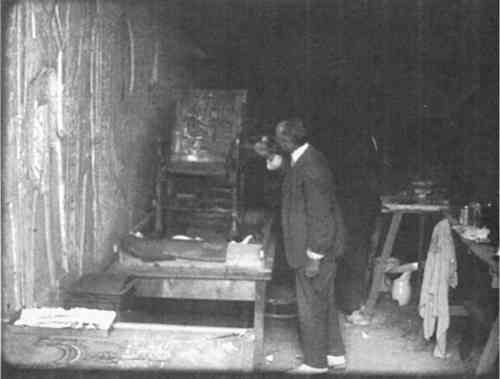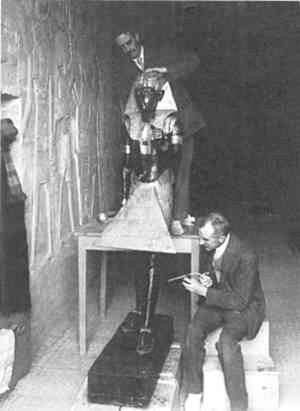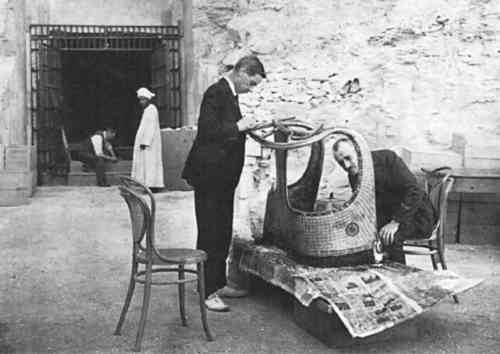ALFRED LUCAS: EGYPT'S SHERLOCK HOLMESMARK GILBERG
4 THE CAIRO MUSEUM AND THE TOMB OF TUTANKHAMENIn March 1923, at the age of 55, Lucas retired from the civil service to pursue his interest in Egyptian archaeology. For years he had maintained a small chemical laboratory at his flat at Gresham House in Garden City (Brunton 1947). It was there, with the aid of a small electric furnace, that he was able to reproduce ancient faience, the composition of which was a matter of great dispute. Within a month of his retirement, Lucas was appointed consulting chemist to the Egyptian Department of Antiquities in Cairo, where he served in both an official and unofficial capacity until his death in 1945. In 1932 his contract was not renewed though he remained at the museum working as a volunteer until December 1934 when, once again, he was given official status with a small salary. Lucas was fascinated with the technical achievements of the ancient Egyptians. Over the years he published the results of numerous studies describing the composition and method of manufacture of a range of ancient Egyptian materials. These studies eventually culminated in the publication of the first comprehensive treatise on the subject, entitled Ancient Egyptian Materials(Lucas 1926). First published in 1926 and later extensively revised in successive editions, it grew to become a standard textbook, laying the groundwork for many of the most important advances in Egyptology (Stoley 1927; Plenderleith 1935). The significance of this work cannot be overestimated. At the time of its publication, few archaeometric studies of ancient Egyptian materials had been conducted with any degree of rigor, and inferences were often made based on incomplete or inconclusive evidence. Lucas brought a muchneeded sense of objectivity to the study of ancient Egyptian materials and succeeded in dispelling a number of prevailing myths or misconceptions, particularly with regard to the true nature of Egyptian faience and the materials used in Egyptian mummification, as well as the use of antimony. The purported use of antimony by the ancient Egyptians was particularly controversial. Antimony plating in Egypt had been reported in the literature by Fink and Kopp (1933), who described several copper objects possessing scattered surface spots that they identified as metallic antimony. Lucas disputed their findings and suggested that the presence of the metallic antimony was more likely the result of the electrolytic reduction process used to clean the objects (Lucas and Harris 1989). Antimony, according to Lucas, was not an uncommon impurity in ancient Egyptian copper objects, and electrolytic reduction may have brought about the reduction of antimony corrosion products to the metallic state, thus producing the appearance of plating. Lucas's work, however, was not always welcomed by the archaeological community. Neither an archaeologist nor a historian by training, Lucas was considered an interloper by some, though most archaeologists respected and admired his contributions. Some of these criticisms were warranted. His published works frequently lacked adequate descriptions of the tests and procedures he used to analyze Egyptian antiquities, while many of his reference citations were incomplete. Not long after his arrival at the Cairo Museum, Howard Carter approached Lucas to assist him in the scientific examination and preservation of the antiquities excavated from the tomb of Tutankhamen (Carter and Mace 1927–33; James 1992). Carter was indeed fortunate to secure the services of Lucas, given his reputation as an experienced chemist with an interest in archaeology. Lucas proved to be one of Carter's most loyal and dedicated supporters and served him well throughout many seasons of excavation. Though the motives and intentions of many of the individuals associated with the excavation of the tomb of Tutankhamen were often called into question, Lucas's were always beyond reproach. In a recent historical account of the excavation of the tomb, Lucas was portrayed as probably the only truly honest person
Lucas, along with the talented young archaeologist Arthur Mace (Lee 1992), who had a reputation as a skilled excavator and restorer, established a makeshift laboratory in the empty tomb of Seti II located directly opposite the opening of Tutankhamen's tomb. The antiquities were temporarily transferred there for preliminary treatment prior to the more arduous journey to the Cairo Museum. After treatment and packing, the artifacts were transported by camel or mule to the Nile some six miles away, where they were then loaded onto a steamer for Cairo. Conditions in the tomb were difficult to say the least. In cramped and extremely hot quarters, Lucas and Mace labored long hours trying to keep pace with the antiquities as the tomb was cleared of its contents. Highly descriptive accounts of day-to-day life in this conservation laboratory were published in many popular newspapers (Egyptian Gazette 1923a–c; New York Times 1923a–d; Times [London] 1923a–g). A number of these newspapers included interviews with Lucas, who proved a strong advocate for preservation. In his own right, he did much to popularize conservation by drawing the public's attention to many behind-the-scene activities. In the following
Many of the objects are in such a condition that before they are photographed, recorded, packed, or transported to Cairo they must be cleaned, strengthened and repaired. Any error in treatment might ruin them, and would probably be irreparable. Thus, some of the articles are of wood covered with plaster (gesso), which in turn is gilt or painted, and also frequently ornamented with coloured inlay. How is such an object to be treated? Manifestly, the first thing to do is to remove superficial dust, which may usually be done by means of a small pair of bellows or by gentle brushing with an artist's small, soft, dry bristle. A duster cannot be used, as this might catch in any loose gold and cause damage. After removing the loose dust, although there is considerable improvement in the appearance, neither the gold (or paint) nor inlay is yet bright and clean. At this stage it frequently seems probable that treatment with water might be helpful, but before water is used it must be known whether it will cause any injury. What will be the effect of water on the dry wood, what on the gilt or paint, what on the gesso, what on the inlay, and what on the cementing material? Before these questions can be answered the nature and properties of all these materials must be analyzed. The nature of the materials must also be known before the object can be correctly described. What, for example, is the composition of the coloured inlay? Is it glass, faience, or stone? Very little chemical work has been done on many of the problems mentioned, and of that little a considerable proportion of the results are so scattered in scientific journals that they cannot easily be traced. Frequently, too, the chemist has not been in sufficiently intimate contact with the archaeological side of the question and, therefore, from the results of a single analysis of a small fragment of a specimen, about which he knows little or nothing, he refrains from giving a definite opinion. At this point, too, other chemical problems present themselves. For instance, what are the nature and cause of the strongly adherent amorphous coating frequently found on faience inlay or the white coating on faience vessels? From the reply to these questions the nature of the chemical changes that have taken place may be deduced and so methods of cure may be devised. A chemical analysis, therefore, of all surface incrustations or deposits is essential. Again, what is the composition of the various cementing materials originally used? How was the gesso made to adhere to wood or gold fastened to gesso? What cement was used for inlay on gesso and for inlay on jewelry, respectively? What is the best cementing material for refastening loose gold or loose inlay, since a material employed by the Ancient Egyptians in the dry climate of Upper Egypt is not necessarily suitable for the damper climate of museums? Lucas and Mace developed an impressive system of documenting the condition and treatment applied to the individual objects using cross-referenced index cards that can still be found in the Griffith Institute at Oxford (McLean and McDonnell 1992). Treatment was minimal. Objects were cleaned of dirt using soft bristle brushes and bellows and, if necessary, strengthened by impregnation with paraffin or beeswax, or celluloid (cellulose nitrate) dissolved
Altogether, Lucas worked nine full seasons at Luxor. The remainder of his time was spent in Cairo performing chemical analysis and preparing objects for exhibition. During the summer months he traveled to England to visit family and consult with colleagues at the British Museum, where he was already a legendary figure known as “Tutankhamen's doctor” (Edwards 1993). Throughout his life Lucas remained intimately involved with the care and preservation of the antiquities excavated from Tutankhamen's tomb. He even assisted in their packing and unpacking when the objects were moved from the museum during World War II as a safeguard against bombing by the Italians. Without a doubt, the survival of many of these antiquities can be attributed to his singular efforts. One event, in particular, epitomizes Lucas's devotion. When the British Broadcasting Company wanted to record the sound of one of Tutankhamen's silver trumpets, a musician from the army unit in the Kasr el-Nil barracks was asked to come to the Cairo Museum to play it the night before the broadcast (Edwards 1993). When no one was looking, he slipped a mouthpiece In 1924 Lucas published his most definitive work on the preservation of archaeological artifacts. Antiquities: Their Restoration and Preservation drew heavily upon his experience with the treatment of Tutankhamen's tomb (Lucas 1924). Though it contained few technical advances, it was nonetheless significant for its overall approach to the treatment of archaeological materials. Lucas's guiding philosophy was relatively simple. To preserve an object, its composition and method of manufacture must be thoroughly understood as well as the exact nature of the change or deterioration that has occurred. Moreover, the long-term impact of the proposed method must be taken into consideration when planning a treatment. To this end, Lucas foresaw the need for a much more scientific approach to the treatment of archaeological materials. At the same time he recognized the need for highly skilled craftsmen capable of undertaking the actual treatment. He believed this blending of art and science in conservation could be achieved only through the combined efforts of dedicated scientists and conservators. He wrote:
Though his most important work was associated with the tomb of Tutankhamen, Lucas provided invaluable assistance to American, English, and French excavators active in Egypt during the early 1900s. His efforts on behalf of George Reisner, in particular, did much to secure the preservation of the antiquities excavated from the Tomb of Queen Hetep-heres, the mother of Cheops (Reisner 1928, 1929, 1955). The preservation of many of the antiquities excavated by Pierre Montet from the intact burial of King Shashanq at Tanis also owes much to Lucas (Brunton 1939). Lucas's efforts on behalf of other archaeologists, however, remain poorly documented in the literature though references to his analytical work can be found throughout the published work of Engelbach (1946), Brunton (1930), and others. |






